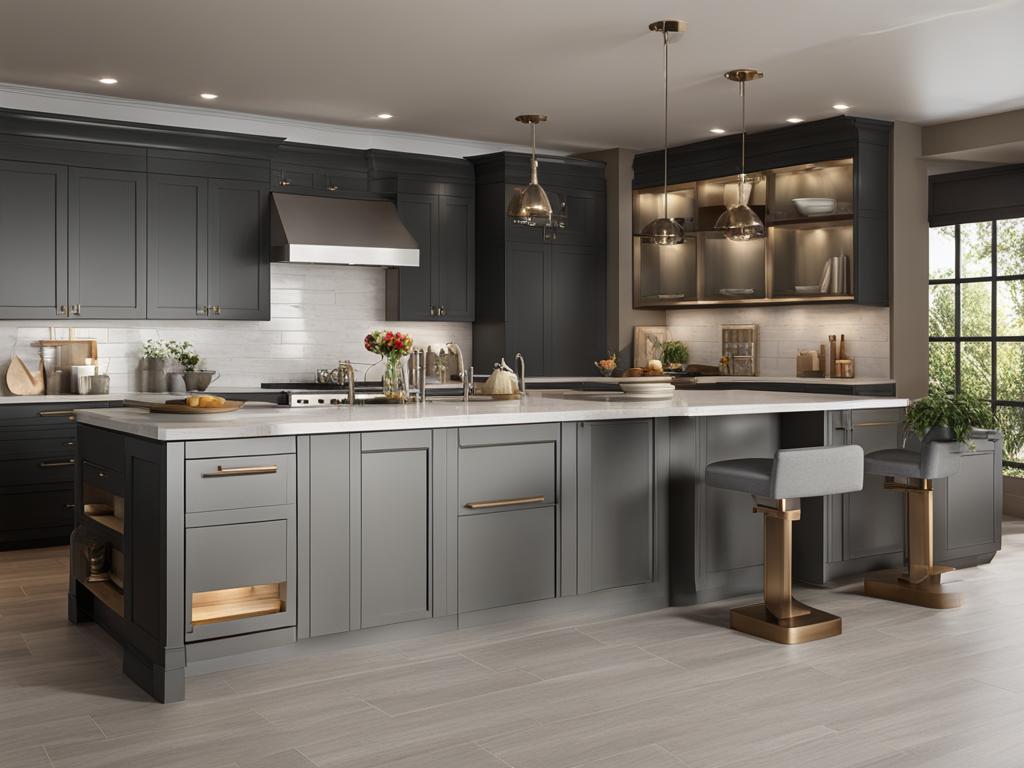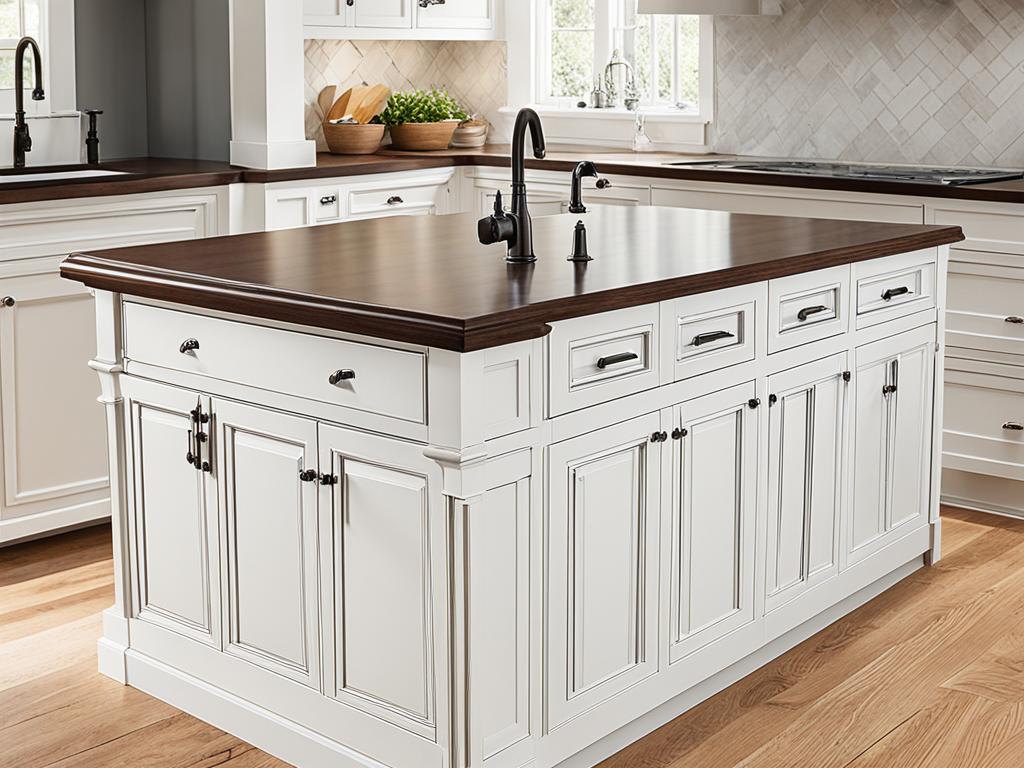When it comes to kitchen cabinets, every detail matters. From the choice of materials to the finishing touches, each decision contributes to the overall style and functionality of the space. Two key elements to consider when designing your cabinets are toe kick and base molding. These features not only add a polished look to your kitchen but also serve practical purposes. Let’s explore the advantages and installation of toe kick and base molding in kitchen cabinets.
Key Takeaways:
- Toe kick and base molding are decorative elements that enhance the style of kitchen cabinets.
- Toe kick provides ergonomic design, while base molding covers the gap between the cabinets and the floor.
- The installation process for both toe kick and base molding is relatively simple.
- Consider factors such as cost, storage space, and difficulty of installation when choosing between toe kick and base molding.
- Ultimately, the choice depends on personal preference and the desired aesthetic for your kitchen.
What is Furniture Base Molding for Cabinets?
Furniture base molding is a decorative trim that is installed at the base of cabinets, covering the gap between the cabinets and the floor. It adds a touch of elegance and a finished look to the kitchen. Base molding comes in a variety of styles and colors, allowing for customization to match the cabinets’ style.
Whether you prefer a simple and understated base molding or a more elaborate and ornate design, there are options available to suit your desired aesthetic. You can choose from different materials, including wood, laminate, and metal, depending on your preferences and the overall design of your kitchen.

Furniture base molding is not only visually appealing but also easy to install. With just a few simple steps, you can transform the look of your kitchen cabinets and give them a touch of elegance. Installing base molding not only hides the gap between the cabinets and the floor but also adds a sense of continuity and completeness to the overall design.
Advantages of Toe Kick and Base Molding
When it comes to kitchen cabinets, both toe kick and base molding offer various advantages that contribute to the overall functionality and appearance of the space. Let’s explore the benefits of each option:
1. Ergonomic Design
Toe kick provides an ergonomic design that ensures comfortable standing while working in the kitchen. By creating a recessed space at the bottom of the cabinets, toe kick prevents back pain and fatigue, making kitchen tasks more enjoyable and efficient.
2. Aesthetic Appeal
Both toe kick and base molding enhance the aesthetic appeal of the kitchen. Toe kick creates a seamless transition between the cabinets and the floor, adding a polished and cohesive look to the space. Base molding, on the other hand, can be a decorative trim that brings elegance and style to the cabinets.
3. Easier Cleaning
Cleaning under the cabinets can be a challenge, as dirt and debris often accumulate in that area. However, toe kick makes cleaning easier by providing access to the floor beneath the cabinets. This prevents dirt buildup and ensures a cleaner kitchen environment. Base molding, although not as effective as toe kick, still simplifies the cleaning process by covering the gap between the cabinets and the floor, reducing the risk of dust and dirt getting trapped.
4. Cost
When considering the cost, it’s important to note that toe kick generally requires additional materials and labor during installation, which can increase the overall expense of the kitchen cabinets. Base molding, being a simpler and more straightforward option, usually comes at a lower cost, making it a more budget-friendly choice for homeowners.
5. Limited Storage
Toe kick occupies some storage space at the bottom of the cabinets, as it requires a recessed area for optimal functionality. If you have limited storage in your kitchen, this may be a downside to consider. On the other hand, base molding does not affect the storage capacity of the cabinets, allowing for maximum use of the available space.
6. Difficult to Install
While base molding is relatively easy to install, toe kick can be more challenging due to its ergonomic design requirements. Proper installation of toe kick involves precise measurements and careful construction to ensure a seamless fit with the cabinets. If you’re not experienced in cabinet installation, it’s recommended to seek professional assistance for toe kick implementation.
Consider these factors when choosing between toe kick and base molding for your kitchen cabinets. Assess your priorities, budget, and available space to make an informed decision that best suits your needs and preferences.

Conclusion
When it comes to kitchen cabinet design, choosing between toe kick and base molding depends on personal preference and the desired style and functionality. Toe kick offers an ergonomic design, allowing for comfortable standing and preventing toe bumps. It also adds aesthetic appeal by creating a seamless transition between the cabinets and the floor. Additionally, toe kick makes cleaning under the cabinets easier, reducing the accumulation of dirt and debris.
On the other hand, base molding provides a decorative trim that covers the gap between the cabinets and the floor, adding a finished look to the kitchen. It offers aesthetic appeal and can be customized to match the cabinets’ style. Base molding also facilitates easier cleaning, ensuring a clean and polished appearance.
While both options have their advantages, it’s important to consider the drawbacks as well. Toe kick comes with added cost and takes up storage space, which might be a concern for some homeowners. Installing base molding can be challenging, requiring proper measurements and precision.
In conclusion, when deciding between toe kick and base molding for kitchen cabinets, consider the overall design and functionality you desire. Assess the pros and cons of each option and choose the one that aligns with your preferences and needs. Whether you opt for the ergonomic design of toe kick or the decorative appeal of base molding, both options can enhance the style and functionality of your kitchen cabinets.
FAQ
What is the difference between toe kick and base molding in kitchen cabinets?
Toe kick is a recessed space at the bottom of the cabinets that provides ergonomic design and prevents toe bumps. Base molding, on the other hand, is a decorative trim that covers the gap between the cabinets and the floor, adding a finished look to the kitchen.
What are the advantages of toe kick in kitchen cabinets?
Toe kick provides ergonomic design, allowing for comfortable standing and preventing back pain and fatigue. It also enhances the aesthetic appeal of the kitchen by creating a seamless transition between the cabinets and the floor. Cleaning under the cabinets is easier with toe kick, as it prevents the accumulation of dirt and debris.
What are the advantages of base molding in kitchen cabinets?
Base molding offers aesthetic appeal and makes cleaning under the cabinets easier. It adds a refined and finished look to the kitchen, covering the gap between the cabinets and the floor.
How is toe kick installed in kitchen cabinets?
Toe kick can be installed with relative ease by attaching it to the base of the cabinets using screws or nails. It is important to measure and cut the toe kick to the correct dimensions for a seamless fit.
What is the installation process for base molding in kitchen cabinets?
Installing base molding can be more challenging compared to toe kick. It involves cutting the molding to the correct length, attaching it to the cabinet base using adhesive or nails, and ensuring a secure and seamless fit.
Source Links
- https://kitchenexpressnc.com/do-kitchen-cabinets-need-a-toe-kick/
- https://nelsonkb.com/what-is-furniture-base-molding-for-cabinets-and-how-to-use-it/
- https://www.deancabinetry.com/what-is-a-toe-kick-in-kitchen-cabinetry-design/
